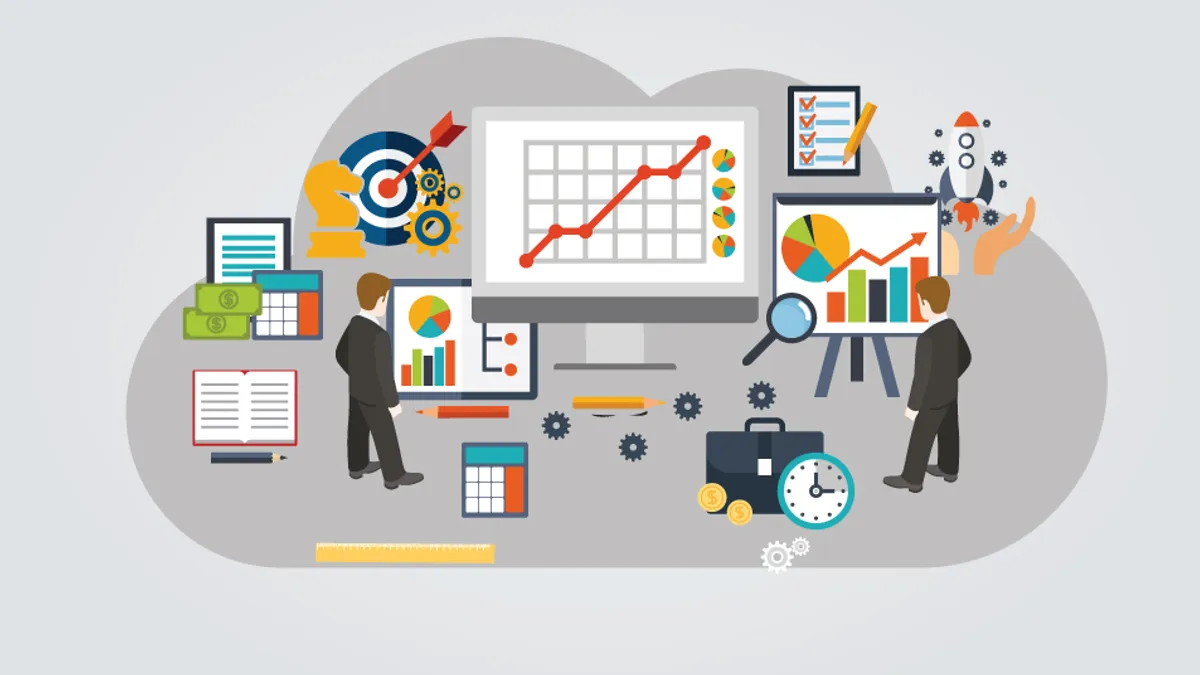Editor's Note: This piece was written by Paige Leuschner, a research analyst at Navigant Research in the Utility Transformations program. The opinions represented in this piece are independent of Smart Cities Dive's views.
A phrase hyped around a variety of industries, data analytics has futuristic and hopeful possibilities for efficiency gains and optimization. Analytics involves using algorithms to identify patterns in data that can provide actionable insights, and can be used to improve city parking and reduce traffic congestion, increase building energy efficiency, foster safer streets, reduce energy consumption in homes, and generally create smarter cities and businesses. As a node in broader smart cities, homes can utilize analytics to enable more advanced functionality that can then morph them into dynamic grid assets in the Energy Cloud. The concept of a smart, connected home continues to gain traction, and stakeholders are increasingly exploring analytics solutions to push this vision forward.
How it works
The storage, analysis and delivery of smart home data to a user platform involves multiple technologies and processes, and are depicted in the figure below. Each step of the process can involve data analytics — from local analytics (a technology trend known as fog computing) to analytics in a server offsite (a technology trend known as cloud-based analytics) — and this depends on the type of data a device is transmitting. For example, some energy monitors, such as Smappee, locally employ analytics because the device produces copious amounts of granular data, and it does not make sense to send all of this information to the cloud.
As smart home technology adoption grows and more data is produced, companies should experiment with employing analytics along different parts of the technology stack to avoid major bandwidth and storage issues that require expensive investments in IT infrastructure.
Current state of the market
Smart home data analytics solutions are currently focused on customer engagement. In the energy industry, utilities are employing these solutions to provide customers with more information about their energy consumption and specific ways in which they can reduce use and save on energy bills. This information is often presented to consumers via a mailed energy report (commonly known as a home energy report), a web portal or a mobile app. Vendors offering data-based utility-customer engagement solutions include Tendril, Bidgely, Whisker Labs, Apogee Interactive and Opower, among others.
Hardware vendors are also involved in the smart home data analytics market by including free analytics with the purchase of hardware. An example of a company employing this business model is Nest, which offers its Learning Thermostat customers an app that reveals user energy consumption and recommendations on how to reduce usage. The thermostat itself also employs analytics to learn consumer behavior patterns for automatically adjusting the thermostat temperature based on lifestyle. Though consumers do not pay for these capabilities directly, companies generate revenue for these analytics services through the initial price of the device.
Analytics are also increasingly being used to offer services to consumers. British Gas, for example, is offering a new service in partnership with Worcester Bosh called Boiler IQ, which detects a boiler’s performance and notifies customers when it is malfunctioning. This service ranges in price from £12.00 to £20.50 per month (approximately $15.35 to $26.23), and is charged directly to consumers.
Future analytics applications in the smart home
Customer engagement is only the beginning of what can be done with residential analytics solutions, and stakeholders in this space have begun to scratch the surface of the available opportunity data has to offer. Though the market is still emerging, analytics solutions have the potential to be used for much more advanced applications, such as automation in the smart home.
Analytics can be expected to foster whole-home integration of various Internet of Things devices by increasing awareness across multiple facets of the home, from thermostats to door locks to refrigerators to solar panels. Having insight across the entire home can enable machine learning and artificial intelligence technologies to eventually create smarter, more intuitive systems that not only make consumers’ lives more convenient, but also play a role in smart cities and the larger digitalized grid.
Challenges to overcome and opportunities for the future
There are still many challenges for the smart home data analytics market to overcome, and it is important to be realistic. Data privacy and security are arguably the biggest barriers for these solutions. In recent years, data hackings have become more frequent and have effected big-name companies from Yahoo to Sony to Target — all of which have experienced security breaches of consumer data. Such instances make consumers hesitant about adopting technologies that utilize their data. In certain regions, like Europe, there are strict laws protecting consumer data, but these also prevent companies from experimenting with data to create new services and from exploring how to add value to existing solutions.
Interoperability and lack of education about the value of these technologies also inhibit market growth. In the connected home, devices that cannot communicate with each other due to incompatible protocols and communicating technologies result in disparate and inaccessible streams of data that cannot be used to create value. Some service providers are also skeptical about the value that data can add to their business; the nascencey of this market means there are not many concrete examples of how analytics can improve operations, which makes it difficult to justify the return on investment (ROI) of these solutions.
Best practices
There are several best practices that can help stakeholders overcome issues in the smart home data analytics market and help turn the smart home into a reality:
- Focus on positive ROI: Analytics must be put toward strong use cases that add value, create new revenue streams, and provide consumers with additional services to positively effect a business.
- Develop strategy for business-to-consumer services: The ultimate goal for vendors in the analytics market is to transition from selling hardware with a one-time payment and free analytics to services that provide ongoing revenue. Vendors must develop a strategy for educating the market on data-based services, and they must go to market with the right value propositions.
- Ensure data privacy and security: It is important for vendors across all aspects of the value chain to reassure consumers about the security of their respective solutions and privacy of their data. It is also important for consumers to stay informed and be aware of how their data is being used.
- Create open and interoperable solutions: The smart home market is fragmented, but its future relies on device and data interoperability. Vendors across the value chain will benefit from shared data streams and communicating devices, as open ecosystems provide more value to consumers.


















